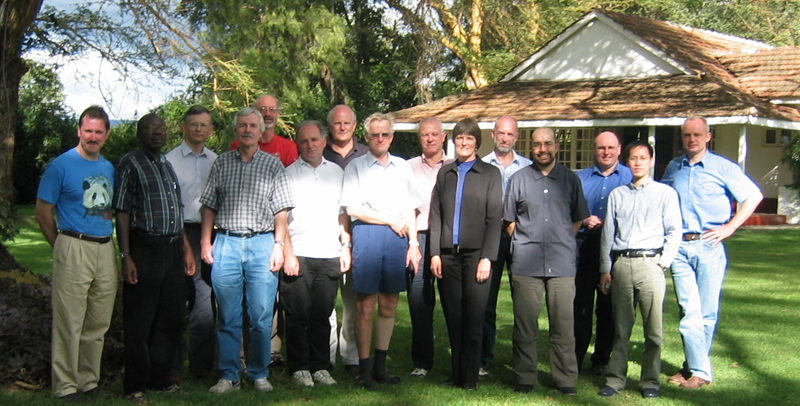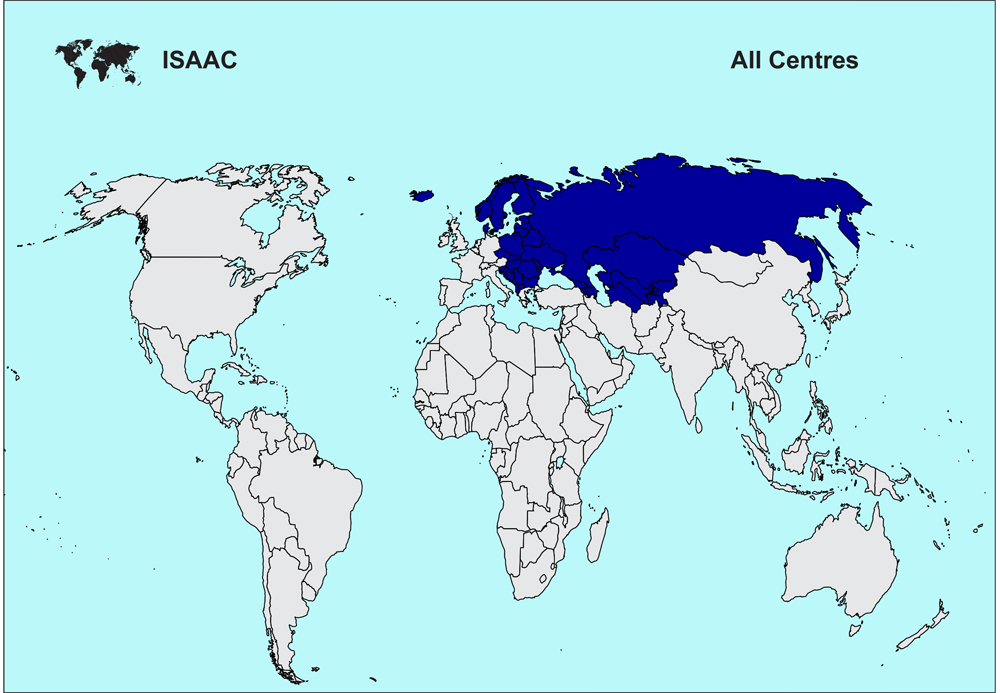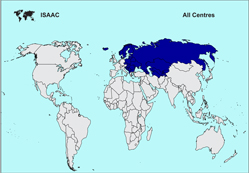

Regional Publications
The following publications used ISAAC data from the Northern and Eastern Europe region:
- Björkstén B. Epidemiology of pollution-induced airway disease in Scandinavia and Eastern Europe [Review]. Allergy 1997; 52(38 Suppl): 23-5; discussion 35-6.
- Björkstén B, Dumitrascu D, Foucard T, Khetsuriani N, Khaitov R, Leja M, Lis G, Pekkanen J, Priftanji A, Riikjärv MA. Prevalence of childhood asthma, rhinitis and eczema in Scandinavia and Eastern Europe. Eur Respir J 1998; 12(2): 432-7.
Northern and Eastern Europe Region
Countries
| Country | Phase One Centres | Phase Two Centres | Phase Three Centres |
|---|---|---|---|
| Albania | 1 | 1 | 1 |
| Bulgaria | 1 | ||
| Croatia | 1 | ||
| Estonia | 2 | 1 | 1 |
| Finland | 4 | 1 | |
| Georgia | 2 | 1 | 1 |
| Hungary | 2 | ||
| Iceland | 1 | ||
| Kyrgyzstan | 3 | ||
| Latvia | 2 | 1 | 1 |
| Lithuania | 1 | 3 | |
| Poland | 3 | 2 | |
| Republic of Macedonia | 1 | ||
| Romania | 1 | 1 | |
| Russia | 2 | 1 | |
| Serbia and Montenegro | 5 | ||
| Sweden | 2 | 2 | 1 |
| Ukraine | 1 | 2 | |
| Uzbekistan | 2 | ||
| Total | 23 | 7 | 28 |
Regional Coordinator:
Roles:
- ISAAC Steering Committee
- Regional Coordinator for Northern and Eastern Europe
Professor Bengt Björkstén
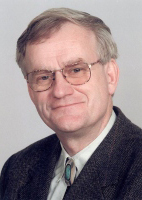
National Institute of Environmental Medicine /IMM
Division of Physiology
Karolinska Institutet
PO Box 287
Sweden
ISAAC in Eastern Europe; Education and contribution to democratisation
Regional context
The enormous political changes in Eastern Europe in 1989 and 1990 opened an entire region for epidemiological research. During the era of socialist governments, epidemiological studies were mostly conducted in order to confirm the superior health of people living in these countries. The academic system was even more hierarchical than in other parts of the world and leadership was not always exclusively granted on research qualifications. In most universities, the standard of clinical research was not up to international standards and many academic teachers had never published in international peer reviewed journals. In addition, the economic situation was very difficult in all the countries. This was the situation when ISAAC entered into research-wise virgin territory.
The opportunity to participate in an international study attracted clinicians in 16 centres in 10 countries; Albania, Estonia, Georgia, Latvia, Lithuania, Poland, Romania, Russia, Ukraine and Uzbekistan. The regional co-ordination was done in Sweden and as a consequence the seemingly illogical ISAAC region “Northern and Eastern Europe" was created.
There was a reason to co-ordinate all centres in the formerly socialist countries from one place; academic structures in these countries were hierarchic and in most cases the seniors on top of the pyramid had little experience of actually conducting studies, in which strict adherence to an agreed protocol was required. The challenge was therefore to find young, flexible persons were open to learn from outsiders and lacking prestige, would accept to be co-ordinated and, at the same time, it was essential that the senior heads would accept that a study was performed in his department but without his direct control.
Most of the 16 local studies in the region were conducted over a three-year period, starting in March 1993. All salaries were funded locally but ISAAC could provide modest financial support for printing costs and stamps. The lack of financial resources was well compensated for by the enthusiasm of the local and national investigators. Many practical issues were solved ad hoc, participation rates were high and data were compiled and diligently reported to the regional centre.
Regional findings
So what was found? It was confirmed in many countries that allergy associated symptoms are much less common in Eastern, as compared to Western Europe, thus confirming the then novel hypothesis that the increasing prevalence of allergies in the west was due to a changed life style, probably less exposure to microbial diversity. An interesting finding was that in all the formerly socialist countries, the peak months of rhinitis symptoms occurred during the winter months, in contrast to the spring-summer peaks recorded in the Scandinavian countries in the region.
Regional impact
The impact of ISAAC in the region goes far beyond the epidemiological data of high quality that were generated in the centres. The investigators were mostly clinically working doctors with little previous experience of research. Participation in ISAAC provided research education and practical experience. Working with computers was a new experience for some.
Participation in a large global research project was a new experience and was for many a practical consequence of the freedom their country. This was perhaps particularly obvious in the Baltic countries and Poland. The informal, consensus-oriented, democratic structure of ISAAC set an example for others.
For many of the local investigators, participation in ISAAC became a starting point for further clinical research of such quality that their results could be published internationally. Many of the investigators also inspired and encouraged colleagues to launch epidemiological studies in other fields, mostly in paediatrics.
It is reasonable to conclude that the significance of ISAAC in Eastern Europe went far beyond the epidemiological data on childhood allergies that were generated. In a small fashion, ISAAC contributed to the democratization process by empowering hard working clinical researchers and exposing the academic system to alternatives to traditional hierarchical structures.
Anglophone Africa
Regional Coordinator, Joseph Odhiambo
Background:
In Africa, especially sub Saharan Africa, the dominant burdens of poverty-related diseases such as acute respiratory infections, malaria, tuberculosis, HIV and malnutrition have over-shadowed equally economically devastating burdens of allergic disorders such as asthma, rhinitis and eczema. Due to earlier perceptions that these disorders were rare in Africa, epidemiological studies to test the hypothesis that parasitic and other infections prevalent in the continent are protective of asthma have been considered
Africa is made up of some 50 countries which contribute to vast diversities in race, culture, languages and socio-economic levels. The continent has a population of 680,000,000 people and this contributes to about 10% of the world population. Based on her colonial history, African countries are broadly divided into English-speaking (Anglophone) and French-speaking (Francophone) groups but there are also pockets of Portuguese speaking groups in the south and largely Arab-speaking or Arabophone groups in the north. About 15 countries speak English.
The International Study of Asthma and Allergies in Childhood (ISAAC) was formed 20 years ago to facilitate research into asthma, allergic rhinoconjunctivitis and atopic eczema using standardised epidemiological tools and approaches between centers in different countries worldwide, including those in Africa. Out of 56 countries and 156 centers that participated in ISAAC Phase One worldwide, Anglophone Africa contributed 4 countries and 6 centers, respectively. Similarly, out of 90 countries and 237 centers that participated in ISAAC Phase Three worldwide, Anglophone Africa also contributed 4 and 6, respectively. Due to limited resources, participation of Anglophone Africa in ISAAC Phase Two studies, which were both labor and resource intensive, was extremely limited, Although the contribution of this region to the international ISAAC data base appears small, the impact of ISAAC, as explained below, has been immense and continues to grow by the day.
Prof Gabriel Anabwani, my mentor in pediatric cardiology at the University of Nairobi many years ago, was the Anglophone Africa Regional Coordinator at the inception of ISAAC and took responsibility for successful conduct of ISAAC Phase One in this part of the world. Anglophone Africa and indeed the whole world is indebted to Prof Anabwani whose invaluable contribution is well documented in several ISAAC publications and the ISAAC website.
At personal level, I have been greatly honored not only for the opportunity to coordinate the implementation of ISAAC Phase III, but also for the opportunity to work together in Africa with Prof Nadia Aït-Khaled, the Regional Coordinator for Francophone Africa. Prof Aït-Khaled has done a great job not only at consolidating Africa’s ISAAC data in published reports, but also spearheading efforts to expand access to life-saving asthma treatment. Best of all has been the opportunity to work together with great professional minds that constitute the ISAAC Steering Committee and contribute, in some ways, to better understanding of the epidemiologic basis and management of asthma and other allergic disorders in Africa and the world at large.
Regional findings in Anglophone Africa and their interpretation
- Although only three countries (Kenya, Ethiopia and S Africa) participated in ISAAC Phase One, the outcome provided valuable information and data on prevalence patterns and potential risk factors for asthma, allergic rhinitis and eczema in Anglophone Africa.
- In ISAAC Phase Three, participation expanded to four countries with inclusion of Nigeria.
- The large variations in the prevalence of the three diseases within countries and within centers witnessed globally is mirrored by findings in Anglophone Africa.
- Overall, 15.9% of 13-14 year old participants in Anglophone Africa had “wheeze in the last 12 months”. Several centers (Cape Town, 20.3%; Polokwane, 18.0%; Nairobi, 18.0%) showed relatively high asthma symptom prevalence comparable to those in Europe and elsewhere.
- The prevalence of current wheeze was generally the highest in urban centers (Nairobi, Kenya; Cape Town, S Africa). This position may be attributable to environmental risk factors linked to urbanisation and adoption of western lifestyles. Large differences in urban-rural asthma prevalence rates have been reported separately in African children of the same genetic background although recent reports from S Africa suggest the urban-rural gradient may be narrowing.
- Anglophone Africa centers reported large variation in the prevalence of rhinoconjunctivitis with high rates among 13 – 14 year old children in Cape Town (>20%).
- High eczema rates reported in some centers need to be treated with caution given possible confusion of symptoms with other itchy skin conditions such as scabies that are common in some parts of Africa.
- ISAAC Phase One and Three Anglophone Africa data indicate high rates of asthma, rhinitis and eczema. These findings demonstrate that these are important emerging public health problems in Africa that call for appropriate national and regional policy, political, advocacy and research responses.
- Moving forward, we hope more Anglophone Africa countries will carry out ISAAC Phase One surveys to provide essential and representative data this region critically needs. In addition, resources allowing, we hope those countries that are ready can undertake ISAAC Phase Three studies for the same purpose.
- ISAAC has established networks with organisations such as WHO and IUATLD who are concerned with health in developing countries. It is noteworthy that ISAAC Phase Four provides a platform for developing and expanding the ISAAC website as a resource for collaboration especially with low and middle income countries. This includes management plans and other resources that are useful for managing asthma, eczema and rhinitis.
Reminiscences/thoughts/experiences of participating in ISAAC
- The use of simple, relatively cheap and standardised tools - written and video questionnaires - to generate key global epidemiologic data has been one of the strongest contributions made by ISAAC.
- By showing rather than describing the signs and symptoms of asthma through video captions in ISAAC Phase One and Three, it was thought that this approach would provide more accurate recognition of clinical asthma independent of the cultural backgrounds of the13-14 year old children. For the wheezing to be clearly heard by all children seated in a classroom, we often set the TV volume to sufficiently audible levels. It is an open question to speculate on what proportion of children might have inappropriately responded “no” to what they commonly experienced but thought was not as loud as presented? Could this have lead to underestimation of asthma in settings where such perceptions were common?
- One of important ISAAC milestones was the award of the Guinness World Record. Reference is made to ISAAC’s strength in rallying international collaboration with the “single focus of understanding the trends of asthma, allergic rhinoconjuctivitis and atopic eczema in children all over the world. And with the aim of reducing the personal burden of these diseases” Children constitute the future and any effort that promotes the welfare of mankind’s future is spot on!
Impact of ISAAC in Anglophone Africa
- For those countries that participated in ISAAC Phase One and Three, the prevalence data on asthma, allergic rhinoconjuctivitis and atopic eczema have provided important advocacy tools for policy and prioritisation of these illnesses in national health programs.
- Based on ISAAC findings, efforts are being made by a cross-section of African countries, specially those who participated in ISAAC Phase One and Three to provide increased research funding to identify local environmental and lifestyle risk factors that could be modified to check disease burden in a complementary manner to expanding access to optimised clinical care of the three diseases.
- There is growing interest among countries that had not participated in ISAAC before to use ISAAC tools and approaches to generate similar data to inform national policy and prioritise their research agenda.
- ISAAC and ISAAC epidemiological tools are positively branded products in Anglophone Africa. At scientific meetings in this region, research findings from asthma, rhinitis and eczema epidemiological studies enjoy great credibility if authors quote or adapt ISAAC approaches in their work.
- ISAAC data and ISAAC expertise continues to contribute immensely to policy development and to formulation and use of updated national care guidelines in South Africa, Kenya, Ethiopia and other countries.
- Participation of several ISAAC centers in Anglophone Africa demonstrated the feasibility of involving institutions and clinicians from Africa in rigorous international surveys and provided impetus and opportunity for advancing research in Anglophone Africa
- Kenya was greatly honored to host the ISAAC Steering Committee Meeting in Anglophone Africa in November 2003. The meeting was held at the Naivasha Country Club, located by the shores of Lake Naivasha some 90 km west of Nairobi. This meeting reaffirmed the global spirit and inclusiveness of the ISAAC initiative. The one day Symposium at the Kenya Medical Research Institute (KEMRI) campus in Nairobi after the Steering Committee put together stimulating presentations on epidemiology and clinical care of asthma, rhinitis and eczema by experts provided by the Steering Committee and local Kenyan practitioners. The Kenya audience and expertise were drawn from medical schools, research institutes and medical students. The Symposium provided a unique platform for sharing essential data and evidence-based approaches to clinical care of the three diseases.
Francophone Africa
Regional Coordinator, Nadia Aϊt-Khaled
Background
Very few previous epidemiological studies of asthma or allergies had been done in Francophone Africa, and these were only in adults and only in Algeria, Morocco and Tunisia. Thus, asthma was generally not identified as a public health problem in Francophone Africa, except in big cities in the Maghreb.
ISAAC offered a unique possibility to raise awareness of asthma, with an international collaborative study that uses a reasonably simple methodology based on a standardised questionnaire with precise, standardised procedures that could be used in African countries.
The development of ISAAC in Francophone Africa positively interfaced with my work at the International Union against Tuberculosis and Lung Disease (IUATLD or The Union). ISAAC demonstrated the high and increasing prevalence of asthma, rhinitis and eczema in Africa. By doing so, it highlighted the need for countries to establish or improve the organisation of asthma management in Africa and in other low- and middle-income countries. These results have been crucial and have already increased the political commitment and funding at national and international level for asthma management.
Regional findings in Francophone Africa
ISAAC demonstrated that:
- The prevalence of asthma, rhinitis and eczema is high in big cities of Francophone Africa
- The prevalence is higher in big cities of Sub-Sahara Africa than in the Maghreb
- The prevalence of asthma, rhinitis and eczema increased between Phase I and Phase III in the majority of centres
- Asthma has been identified as a public health issue, not only in the Maghreb but also in Sub-Saharan Africa
- A large part of the diseases are not allergic suggesting the existence of other specific risk factors
- There is a need for new research to examine the new trend of prevalence of these diseases and to explore the existence of other specific risk factors
Impact of ISAAC
Impact in Francophone Africa: The main impact has been the creation of a network of investigators who, despite the limited resources, were interested in participating in future studies in this region. There has been an increase in political awareness of asthma management at a national level in ISAAC countries and the majority of the investigators began to organise management and/or improve management of asthma in their countries.
Impact of ISAAC at The Union: During my activity at The Union as Chief of Asthma Division my involvement in ISAAC study was very positive and played a role mainly in 2 important issues:
- Encouraging operational research on asthma and other respiratory diseases: the majority of ISAAC principal investigators committed their time to participate with me in some collaborative Union studies (asthma in emergency, rhinitis and COPD)
- Creation of the Asthma Drug Facility (ADF): ADF was created by The Union to provide developing countries with quality-assured and affordable essential medicines for asthma. The creation of ADF was promoted by Dr Nils Billo Director, executive of The Union, based on 2 main arguments: Firstly, The Union study identified low affordability of asthma drugs for patients as a main barrier for management of asthma in low and middle income countries and secondly, the ISAAC results identified asthma as a large and increasing public health problem in developing countries.
Impact at the World Health Organisation: As a technical expert participating in several WHO meetings, the ISAAC methodology and results presented during these meetings may have played a role in increasing international political commitment for asthma.
Personal Impact: ISAAC is one of the most important experiences in my professional life. Being a member of ISAAC steering committee has allowed me to discuss, even if I am only a clinician, with other members of the steering committee that have different experiences in the world and different skills, particularly with prestigious epidemiologists and researchers. It has also been a pleasure to work in a such a friendly atmosphere with special colleagues, to meet during the various “ISAAC collaborators reception” different PIs working in different parts of the world. Finally, it is for me a big honour to be a member of “The ISAAC family”
Reminiscences/thoughts/experiences of participating in ISAAC
The main challenges were:
- Scarcity of health personnel or epidemiologists who are capable of conducting scientific epidemiological studies, particularly in sub-Saharan Africa
- The ISAAC Manual was in English and could not be used by the majority of the Francophone African investigators
- Translation of the ISAAC manual into French: thanks to Karen Bissell from IUATLD who helped me to translate the ISAAC manual into French
Our experiences were:
- A limited number of centres were included in Phase I due to the very limited funding for centres. There was no funding for a regional meeting and communication with the centres was difficult.
- A workshop was organised in Paris in 2001 at the HQ of The Union. Phase I investigators participated along with and investigators from other Francophone African countries that are members of The Union to encourage them to conduct ISAAC Phase III in their respective countries
- The number of centres included in Phase III increased dramatically due to the encouraging results from Phase I and the workshop organised in Paris. In addition, communication improved as the regional coordinator was able to use email correspondence to a much greater extent during phase III
- Several presentations of the results were made in international and regional conferences of The Union (the main ones are listed in a footnote)
- A poster session on ISAAC Phase III results was organised with the principal investigators of the region at one of the international conferences in Paris
- Publications were prepared for Morocco centres and for ISAAC Phase III in Africa
- Organisation of the ISAAC Steering Committee in Casablanca (Morocco) in collaboration with the principal investigator of Morocco: this was a big honour for myself as the regional coordinator of Francophone Africa and for all the region to receive the other members of the ISAAC Steering Committee.
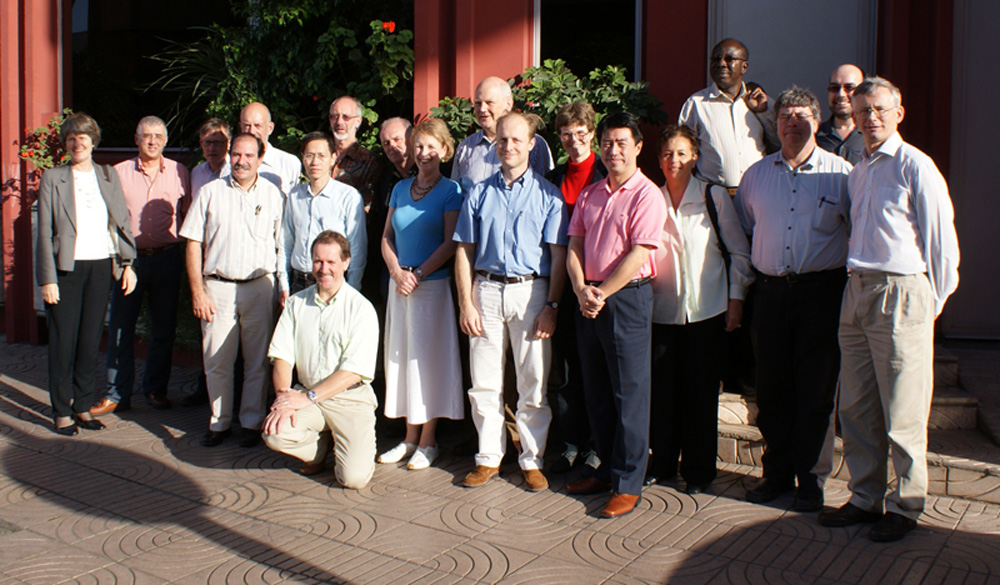
Conclusion
In conclusion, I want to echo the words of Prof Donald Enarson, former director of the IUATLD Scientific Activities, who wrote in his editorial about ISAAC:
“What, to my mind, was most unique about ISAAC was its capacity to engage people in research. ‘Professional’ researchers often have a strange ability to frighten people away from research by emphasising its complexity and intimidating those with little self confidence, thus excluding individuals from what is, in essence, not only something eminently worthwhile but something downright fun. By ‘democratising’ critical thinking, ISAAC has been able to break through this barrier and engage people not previously involved in research in an exercise in disciplined measurement and critical thinking. These are basic skills in the health sciences beyond their utility in research and for this ISAAC is to be heartily congratulated. As stated by the Commission on Health Research for Development, ‘. . . for the world’s most vulnerable people, the benefits of research offer a potential for change that has gone largely untapped’. This report has emphasised the essential nature of research in achieving the changes necessary to improve health globally and the requirement that all public health action must have inbuilt research if it is to be appropriate, efficient and equitable. A major barrier to realising these lofty objectives is the lack of confidence of health care workers in involving themselves in research. ISAAC is to be applauded for addressing this obstacle through open-minded, inclusive collaboration that has produced a base of knowledge that is used globally to inform policy. ISAAC is a model that should be followed by all those of us who are committed to improving public health in low-income countries”
Footnote: ISAAC presentations, meetings, and training in Francophone Africa
- ISAAC Workshop , HQ Union, Paris, 2001. A workshop organised with the participation of Phase I investigators and of investigators from other Francophone African countries to encourage them to conduct in their respective countries ISAAC Phase III
- Poster discussion at the 34th Union World Conference on Lung Health, October 2003, Paris. Presentation of preliminary results of ISAAC III and poster discussion with the PIs of ISAAC Phase III in Africa
- World Asthma Meeting, Bangkok 2004. Presentation on asthma epidemiology in Africa.
- Union Africa Regional Conference, Algiers 2004. Presentations on ISAAC methodology and preliminary results in Africa
- 36th Union World Conference on Lung Health, 18-22 October 2005, Paris. ISAAC III in Africa
- 16th Union Africa Regional Conference, November 2007, Cape Town, South Africa. Asthma Burden in Africa
- The Union World Conference, Paris, 2008. The Union’s reply to the rising prevalence of Asthma in low and middle income countries.
- Presentation of ISAAC update at each annual Lung Department meeting of the Union
- Presentation of ISAAC results at several WHO experts Meetings: 1996-1999 to establish the WHO/TB Initiative “Practical Approach For Lung Health” and since 2007 to establish with WHO/Non-communicable Diseases a new initiative “Approach on Package of Essential Non-communicable Diseases”.
- Presentation of ISAAC methodology and results in several training courses or post graduate courses in Mexico, Syria, Benin, Kenya, Soudan, Algiers, and China.
- ISAAC Phase III results are included in the training module done by The Union for Asthma Drugs Facility Clients.

